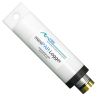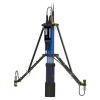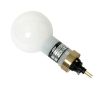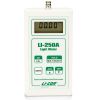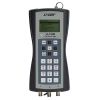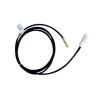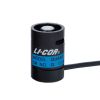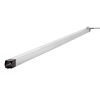Used LI-COR LI-192 Underwater PAR Sensor
Features
- Uses computer-tailored filter glass to achieve the desired quantum response
- Sensor is cosine corrected, and calibration is traceable to NIST
- Features corrosion-resistant, rugged construction for use in up to 560m depths
- Free ground shipping
- Expedited repair and warranty service
- Lifetime technical support
- More
Overview
The LI-192 Underwater Quantum Sensor measures PAR from all angles in one hemisphere. The LI-192 works in air or underwater at depths up to 560 meters. The measurements are cosine corrected and typically expressed as Photosynthetic Photon Flux Density (PPFD). For simultaneous measurements of downwelling and upwelling PAR, two sensors can be mounted on the 2009S Lowering Frame.
Measurement Principle
The LI-192 uses a silicon photodiode and a glass optical filter to create nearly uniform sensitivity to light between 400 and 700 nm, which closely corresponds to light used by most terrestrial and aquatic plants and algae. A precision optical filter blocks light with wavelengths beyond 700 nm, which is critical for measurements in a water column, where the ratio of infrared to visible light may be high.
- Absolute Calibration: +/-5% in air traceable to NBS
- Sensitivity: Typically 4 uA per 1000 umol s-1 m-2 in water
- Linearity: Maximum deviation of 1% up to 10,000 μmol s-1 m-2
- Stability:< +/-2% change over a 1 year period
- Response Time: 10 us
- Temperature Dependence: +/-0.15% per C maximum
- Cosine Correction: Optimized for both underwater and atmospheric use
- Azimuth:< +/-1% error over 360 degrees at 45 degree elevation
- Detector: High stability silicon photovoltaic detector (blue enhanced)
- Sensor Housing: Corrosion resistant metal with acrylic diffuser for both saltwater and freshwater applications
- Waterproof: Withstands 800 psi pressure (560 meter depths)
- Size: 3.18cm Dia. x 4.62cm H
- Weight: 227g
- Mounting: (3) 6-32 holes are tapped into the base for use with the 2009S Lowering Frame or other mounting devices
- Cable: Requires 2222UWB Underwater Cable
In The News
LI-COR PAR sensors detect light waves to aid aquatic ecosystem research
Understanding how the sun’s rays fuel phytoplankton or plant growth may prove valuable to understanding an aquatic ecosystem. A pair of sensors from LI-COR can help researchers studying algal blooms and aquatic vegetation by measuring how much light enters underwater environments. Sitting below the surface, the LI-192 flat-lensed photosynthetically active radiation sensor and the LI-193 spherical PAR sensor measure light waves striking their silicon photovoltaic detectors. They sense light wavelengths between 400 and 700 nanometers, which is the ideal range for photosynthesis. Dave Johnson, a LI-COR product manager for the LI-190 series, said the sensors’ individual designs make them ideal for different applications.
Read MoreOhio State greenhouse nurtures 'fruit fly of the plant world'
The Arabidopsis Biological Resource Center at Ohio State University was established in 1991 with funding from the National Science Foundation. Part of the center’s job is to meet demand for seed of the arabidopsis plant, which is widely used for genetic modeling. “A lot of the plants we’re growing are for seed production,” said Joan Leonard, greenhouse coordinator. “Arabidopsis is a good example. We call it the ‘fruit fly of the plant world,’ and it takes about six to eight weeks to go from seed to plant.” Arabidopsis is one of the many plants that will benefit from a new LI-COR PAR sensor being installed on campus. It will help manage light schedules for greenhouse plants.
Read MoreFloating Global New Ideas: Buoy-Enabled Research at Florida Agricultural and Mechanical University’s School of the Environment
Florida Agricultural and Mechanical University (FAMU), based in Tallahassee, Florida, is the highest-rated public Historically Black College or University in the United States. FAMU’s School of the Environment (FAMU-SOE) offers BS and BA degrees in Environmental Studies, and BS, MS, and Ph.D. degrees in Environmental Science, with specialisms available in areas including Environmental Policy and Risk Management, Aquatic and Terrestrial Ecology, and Biomolecular Sciences. In 2021, FAMU-SOE deployed a NexSens CB-450 buoy in Apalachee Bay, a key oyster farming area around 30 miles south of Tallahassee. The buoy has quickly been incorporated into the curriculum, providing environmental insights for student research, the community, and beyond. Dr.
Read More















